All vehicles have something in common and it doesn't matter if you are driving a two-door car, a full ton pickup or anything in between – you need to know your gross vehicle weight rating, since exceeding this weight limit means overloading your vehicle and could cause major damage to your vehicle, yourself or others.
What Is GVWR, Anyways?
GVWR stands for Gross Vehicle Weight Rating, and it refers to the maximum amount of weight that your vehicle can safely carry, including its own weight, all of the people riding in the vehicle and all cargo that you will be carrying.
The GVWR of your vehicle is a very important specification that you need to know, especially if you plan on carrying a significant amount of passengers, cargo or both!
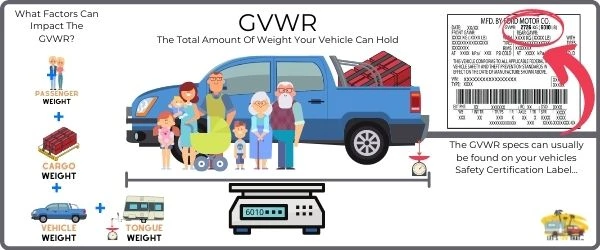
You should never load your vehicle beyond its gross vehicle weight rating since doing so will cause a number of potentially serious issues for your vehicle and even for the other drivers on the road.
What Does The GVWR Include?
To be specific, the GVWR usually includes the curb weight of your vehicle, all fluids topped off (oil, coolant, transmission fluid, fuel, etc.), the tongue weight of the trailer (if you have one attached), all passengers and cargo that will be riding in the vehicle and any sort of accessories or extra components that have been installed from the factory.
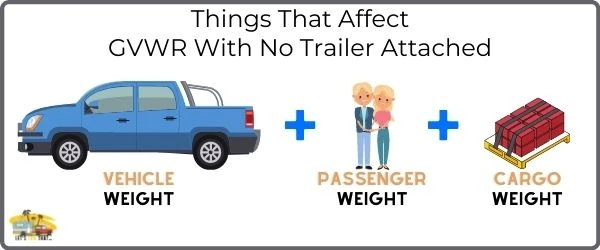
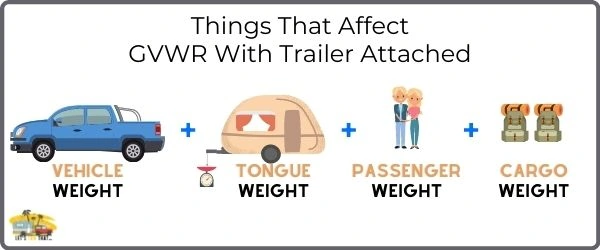
Note: Any equipment or modifications you add to the vehicle itself is not calculated in the GVWR specs and you will have to deduct the weight of everything you added from the GVWR specified.
A Real Life Example Of How To Use The GVWR Spec...
As an example, the 2021 Honda Ridgeline has a GVWR of 6,019 pounds – easily more than what you can imagine would fit inside it's cab, but if you were planning on hauling concrete, rocks, sand or something else that is very heavy, then you could potentially run the risk of exceeding your GVWR.
If we take that same vehicle and do a little bit of calculating, we can see what amount of weight we have left after we deduct the vehicle's weight. Let's take the GVWR of 6,019 lbs. and deduct the curb weight of the vehicle, which is 4,510 lbs. for this model. That gives us a difference of 1,509 pounds and that is how much additional weight we can haul.
(GVWR) 6,019 lbs. - 4,510 lbs. (CURB WEIGHT)= 1,509 lbs. (AVAILABLE WEIGHT)
If we have the driver of the vehicle and 3 additional passengers and they all weigh 200 lbs., then we would have to deduct that 800 lbs. from the 1,509 lb. available capacity, which would leave us with 709 lbs. of weight still available.
1,509 lbs. (WEIGHT CAPACITY AVAILABLE) - 800 lbs. (DRIVER AND PASSENGER WEIGHT) = 709 lbs.
If we wanted to go and pick up bags of concrete from the hardware store that weigh 100 lbs. each, then we only have enough capacity to load 7 bags, leaving us with 9 pounds of capacity left.
709 lbs. (WEIGHT CAPACITY AVAILABLE) - 700 lbs. (CONCRETE WEIGHT) = 9 lbs.
This is an extreme example and you really don't want to come this close to your max. GVWR spec because other systems of the vehicle will become more vulnerable too, like cooling, brakes, etc.
Curb Weight:
The curb weight is how much the vehicle weighs without any driver, passenger, cargo or trailer weight. This is just the weight of the vehicle itself with all fluids topped off, ready to drive.
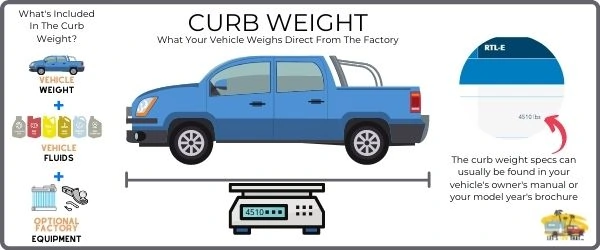
How The GVWR Relates To Towing...
You may have a vehicle that you plan to use for pulling trailers. One thing you need to note is that the gross vehicle weight rating is only slightly affected by towing, since the GVWR is just the weight of everything carried by the vehicle itself, and it does not take into account the weight of the trailer at all.
Even though the GVWR is not related to the towing capacity of your vehicle, the tongue weight of your trailer is still a factor that you need to factor into your GVWR.
Trailers have a tongue weight, which is a portion of its mass that the trailer coupler imparts on to the tow hitch receiver of the tow vehicle, and is in turn mostly borne by the rear axle.
In a properly balanced trailer, the tongue weight is somewhere around 10 to 15 percent of the trailer weight. This weight also takes up some payload capacity of your vehicle as well.
For example, a 2,000 pound trailer may have a tongue weight of 200 pounds that the hitch receiver of your vehicle needs to carry. That’s 200 pounds less capacity for the rest of your passengers and cargo, so if you have a truck that has a payload capacity of 2,000 pounds, then you only have an allowance of 1,800 pounds left for the rest of the stuff that you want to load into your vehicle, if you are to stay below the GVWR.
What Can Happen If You Exceed The Suggested GVWR?
Exceeding the gross vehicle weight rating of your vehicle means you are now driving an overloaded vehicle, and it’s a situation that can result in a lot of issues for you and your vehicle, for a variety of different reasons.
Here is an image of a very extreme case but the weight actually bent the bed of the truck, and possibly the frame too.

Exceeding The GVWR Example
Braking: The first and probably most important, is the way overloading affects the ability of your vehicle to stop. A vehicle that is too heavy will have a significantly longer stopping distance, since the brakes may not have the capability to quickly bring it to a stop, in its overloaded state. As you can imagine, this can result in a situation where you can lose control of your vehicle.
Steering: The steering issues that can result from exceeding the gross vehicle weight rating of your car or truck. Steering and handling are affected by several components of your vehicle – it’s steering components, suspension, axles, wheels, and other parts.
Suspension: Suspension components, in particular, can become ineffective if the vehicle is overloaded. They do a worse job of dampening the shocks on the road, and the handling of your vehicle suffers. Your suspension components can even possibly break down under the added load as well.
Tires: Tires are more like to blow out under the additional pressure and heat generated by supporting an overloaded vehicle, worn-out ones in particular.
How Do I Find the GVWR of My Vehicle?
There are several ways for you to find information on the gross vehicle weight rating of your car or truck. Since the GVWR is a specification that the car manufacturer has already determined for the particular make and model of your vehicle, it’s a number that will not change for the most part – once you find the GVWR of your vehicle, then all you need to do is to jot it down for your records.
The only time that you may need to reconsider the GVWR of your vehicle is if it has undergone some sort of upgrade or downgrade that affects its capabilities.
An older vehicle, or one that has developed issues with some of its components, may have a lower payload capacity than what the GVWR originally indicates, as well.
The quickest way to locate the gross vehicle weight rating of your vehicle is by checking the certification/safety label on the door pillar of your vehicle. This information label is usually located on the driver’s side of your vehicle, and it also includes other important metrics, such as the GAWR, VIN and tire air pressure and size specs for your particular vehicle as well.
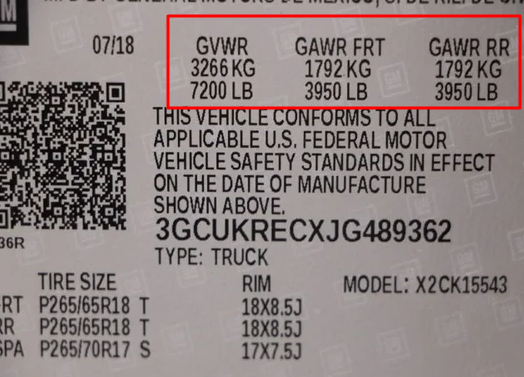
Chevy Certification Label
One of the best ways to find information on the GVWR of your car or truck is by consulting your owner’s manual. It will usually have the location of the certification label and sometimes even state the GVWR specs, along with other helpful weight ratings like GCWR, GAWR, etc.
GVWR on a Trailer
Your vehicle has a gross vehicle weight rating, but if you are a tow driver, then chances are you already know that your trailers also have their own GVWR as well. Just like the GVWR for your vehicle, the gross vehicle weight rating of your trailer includes its own weight, as well as all the accessories needed to tow it safely.
Unlike the GVWR of cars and trucks, the GVWR for trailers has a wider variety of definitions depending on the manufacturer, as well as the region that the trailer was built in. Some trailer makers specify a GVWR based on the lowest component rating on their product. Others determine a GVWR per trailer axle – for example, a trailer with two axles may have a GVWR per axle rating of 6,000 pounds, for a total of 12,000 pounds GVWR.
If you are planning to tow a commercial grade trailer, you will also have to factor in a few other things aside from the weight of your payload. You may have to take into account your pallet fork holders, parking jacks, winches, grapple buckets and other things that you need to haul commercial grade cargo.
What is the difference between GVWR and GVW?
The difference between the gross vehicle weight rating (GVWR) and the gross vehicle weight (GVW) of your vehicle is that the GVWR is a specification, and the GVW is an actual measurable quantity.
The GVWR is the manufacturer’s maximum rated weight that it recommends for your particular vehicle, including its own weight and the load that it carries. The GVW, on the other hand, is the actual weight of your car and truck with passengers, luggage and payload in it.
Finding These Numbers...
The GVWR is clearly posted (usually on the certification label) and usually is a static metric, like we talked about. It is easy to find and can be located and recorded in a matter of seconds.
The GVW, on the other hand, is something that you will have to measure directly. One way to do it is by using a commercial scale designed for vehicles and measure the gross vehicle weight of your vehicle in its current state, as it is loaded with the passengers, cargo and additional accessories.
* Commercial scales can be found in many places like some truck stops, county waste management facilities, local law enforcement offices, etc.
GVW vs GVWR:
The GVW (gross vehicle weight) accounts for the curb weight of the vehicle and includes the weight of the passengers, cargo, aftermarket options you installed that contribute to the GVWR specs listed.
GVW is not a limit like the GVWR is, it is simply just the additional weight you are adding to the vehicle (plus the curb weight).
GVWR vs GCWR
The gross combined weight rating (GCWR) is another important rating you need to look up for your vehicle if you plan to tow a trailer. While the GVWR is the maximum weight capacity of the vehicle loaded with people, luggage and cargo, it’s a figure that does not usually take a trailer into account, except for the tongue weight of the trailer.
The gross combined weight rating or GCWR, on the other hand, does take into account the weight of a hitched up trailer. It includes the weight of the vehicle, the weight of passengers and cargo in it, and then combines it with the weight of the trailer itself.
The GCWR is also referred to as the gross combination mass (GCM), gross train weight (GTW) or maximum authorized mass (MAM).


GVWR vs GAWR
The Gross Axle Weight Rating or GAWR is the maximum weight that can be safely supported by an axle of your vehicle. Since your vehicle usually has two axles, most GAWR information is usually followed by the axle it is meant for. GAWR FR is the rating for the front axle, while the GAWR RR is the rating for the rear axle.
GVWR is a figure that looks at the overall capabilities of the vehicle. The GAWR, on the other hand, is more focused on the capabilities of the axles of your car or truck. You will usually see the GAWR listed alongside the GVWR in the owner’s manual, or in the certification label on the driver’s side door frame.
Example: If we take a pickup truck and use it as an example, we know that the front axle rating will have more of it's capacity taken up by the weight of the engine, which can weigh several hundred pounds, in some cases. The rear axle only has to support the weight of the sheet metal bed, which weighs a lot less, so more capacity will be available for the rear axle, if both axles have the same weight rating.
Last updated on May 10th, 2021 at 05:33 am